Gunhee Kim
Meta-Continual Learning of Neural Fields
Apr 08, 2025Abstract:Neural Fields (NF) have gained prominence as a versatile framework for complex data representation. This work unveils a new problem setting termed \emph{Meta-Continual Learning of Neural Fields} (MCL-NF) and introduces a novel strategy that employs a modular architecture combined with optimization-based meta-learning. Focused on overcoming the limitations of existing methods for continual learning of neural fields, such as catastrophic forgetting and slow convergence, our strategy achieves high-quality reconstruction with significantly improved learning speed. We further introduce Fisher Information Maximization loss for neural radiance fields (FIM-NeRF), which maximizes information gains at the sample level to enhance learning generalization, with proved convergence guarantee and generalization bound. We perform extensive evaluations across image, audio, video reconstruction, and view synthesis tasks on six diverse datasets, demonstrating our method's superiority in reconstruction quality and speed over existing MCL and CL-NF approaches. Notably, our approach attains rapid adaptation of neural fields for city-scale NeRF rendering with reduced parameter requirement.
How to Move Your Dragon: Text-to-Motion Synthesis for Large-Vocabulary Objects
Mar 06, 2025Abstract:Motion synthesis for diverse object categories holds great potential for 3D content creation but remains underexplored due to two key challenges: (1) the lack of comprehensive motion datasets that include a wide range of high-quality motions and annotations, and (2) the absence of methods capable of handling heterogeneous skeletal templates from diverse objects. To address these challenges, we contribute the following: First, we augment the Truebones Zoo dataset, a high-quality animal motion dataset covering over 70 species, by annotating it with detailed text descriptions, making it suitable for text-based motion synthesis. Second, we introduce rig augmentation techniques that generate diverse motion data while preserving consistent dynamics, enabling models to adapt to various skeletal configurations. Finally, we redesign existing motion diffusion models to dynamically adapt to arbitrary skeletal templates, enabling motion synthesis for a diverse range of objects with varying structures. Experiments show that our method learns to generate high-fidelity motions from textual descriptions for diverse and even unseen objects, setting a strong foundation for motion synthesis across diverse object categories and skeletal templates. Qualitative results are available on this link: t2m4lvo.github.io
Distilling Reinforcement Learning Algorithms for In-Context Model-Based Planning
Feb 26, 2025Abstract:Recent studies have shown that Transformers can perform in-context reinforcement learning (RL) by imitating existing RL algorithms, enabling sample-efficient adaptation to unseen tasks without parameter updates. However, these models also inherit the suboptimal behaviors of the RL algorithms they imitate. This issue primarily arises due to the gradual update rule employed by those algorithms. Model-based planning offers a promising solution to this limitation by allowing the models to simulate potential outcomes before taking action, providing an additional mechanism to deviate from the suboptimal behavior. Rather than learning a separate dynamics model, we propose Distillation for In-Context Planning (DICP), an in-context model-based RL framework where Transformers simultaneously learn environment dynamics and improve policy in-context. We evaluate DICP across a range of discrete and continuous environments, including Darkroom variants and Meta-World. Our results show that DICP achieves state-of-the-art performance while requiring significantly fewer environment interactions than baselines, which include both model-free counterparts and existing meta-RL methods.
Sample Selection via Contrastive Fragmentation for Noisy Label Regression
Feb 25, 2025Abstract:As with many other problems, real-world regression is plagued by the presence of noisy labels, an inevitable issue that demands our attention. Fortunately, much real-world data often exhibits an intrinsic property of continuously ordered correlations between labels and features, where data points with similar labels are also represented with closely related features. In response, we propose a novel approach named ConFrag, where we collectively model the regression data by transforming them into disjoint yet contrasting fragmentation pairs. This enables the training of more distinctive representations, enhancing the ability to select clean samples. Our ConFrag framework leverages a mixture of neighboring fragments to discern noisy labels through neighborhood agreement among expert feature extractors. We extensively perform experiments on six newly curated benchmark datasets of diverse domains, including age prediction, price prediction, and music production year estimation. We also introduce a metric called Error Residual Ratio (ERR) to better account for varying degrees of label noise. Our approach consistently outperforms fourteen state-of-the-art baselines, being robust against symmetric and random Gaussian label noise.
Is a Peeled Apple Still Red? Evaluating LLMs' Ability for Conceptual Combination with Property Type
Feb 10, 2025Abstract:Conceptual combination is a cognitive process that merges basic concepts, enabling the creation of complex expressions. During this process, the properties of combination (e.g., the whiteness of a peeled apple) can be inherited from basic concepts, newly emerge, or be canceled. However, previous studies have evaluated a limited set of properties and have not examined the generative process. To address this gap, we introduce the Conceptual Combination with Property Type dataset (CCPT), which consists of 12.3K annotated triplets of noun phrases, properties, and property types. Using CCPT, we establish three types of tasks to evaluate LLMs for conceptual combination thoroughly. Our key findings are threefold: (1) Our automatic metric grading property emergence and cancellation closely corresponds with human judgments. (2) LLMs, including OpenAI's o1, struggle to generate noun phrases which possess given emergent properties. (3) Our proposed method, inspired by cognitive psychology model that explains how relationships between concepts are formed, improves performances in all generative tasks. The dataset and experimental code are available at https://github.com/seokwon99/CCPT.git.
DynamicER: Resolving Emerging Mentions to Dynamic Entities for RAG
Oct 15, 2024Abstract:In the rapidly evolving landscape of language, resolving new linguistic expressions in continuously updating knowledge bases remains a formidable challenge. This challenge becomes critical in retrieval-augmented generation (RAG) with knowledge bases, as emerging expressions hinder the retrieval of relevant documents, leading to generator hallucinations. To address this issue, we introduce a novel task aimed at resolving emerging mentions to dynamic entities and present DynamicER benchmark. Our benchmark includes dynamic entity mention resolution and entity-centric knowledge-intensive QA task, evaluating entity linking and RAG model's adaptability to new expressions, respectively. We discovered that current entity linking models struggle to link these new expressions to entities. Therefore, we propose a temporal segmented clustering method with continual adaptation, effectively managing the temporal dynamics of evolving entities and emerging mentions. Extensive experiments demonstrate that our method outperforms existing baselines, enhancing RAG model performance on QA task with resolved mentions.
Text2Chart31: Instruction Tuning for Chart Generation with Automatic Feedback
Oct 05, 2024



Abstract:Large language models (LLMs) have demonstrated strong capabilities across various language tasks, notably through instruction-tuning methods. However, LLMs face challenges in visualizing complex, real-world data through charts and plots. Firstly, existing datasets rarely cover a full range of chart types, such as 3D, volumetric, and gridded charts. Secondly, supervised fine-tuning methods do not fully leverage the intricate relationships within rich datasets, including text, code, and figures. To address these challenges, we propose a hierarchical pipeline and a new dataset for chart generation. Our dataset, Text2Chart31, includes 31 unique plot types referring to the Matplotlib library, with 11.1K tuples of descriptions, code, data tables, and plots. Moreover, we introduce a reinforcement learning-based instruction tuning technique for chart generation tasks without requiring human feedback. Our experiments show that this approach significantly enhances the model performance, enabling smaller models to outperform larger open-source models and be comparable to state-of-the-art proprietary models in data visualization tasks. We make the code and dataset available at https://github.com/fatemehpesaran310/Text2Chart31.
See It All: Contextualized Late Aggregation for 3D Dense Captioning
Aug 14, 2024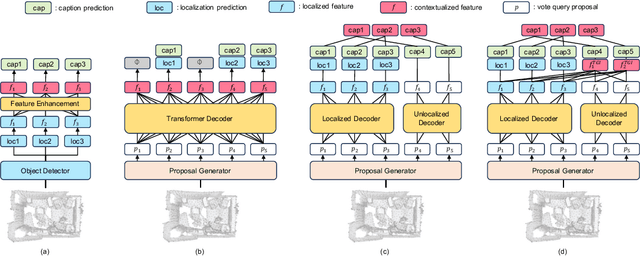
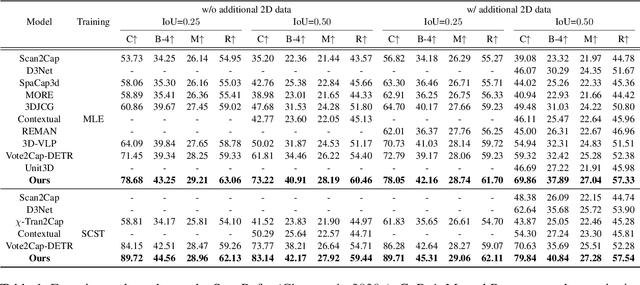
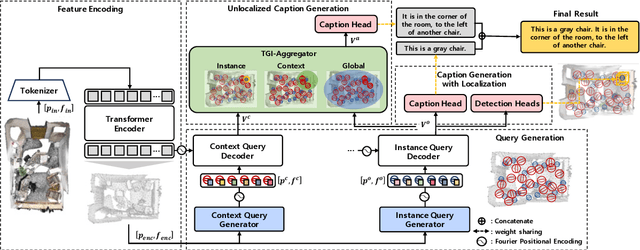
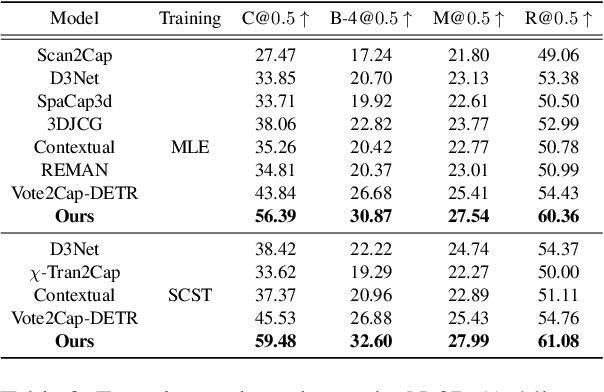
Abstract:3D dense captioning is a task to localize objects in a 3D scene and generate descriptive sentences for each object. Recent approaches in 3D dense captioning have adopted transformer encoder-decoder frameworks from object detection to build an end-to-end pipeline without hand-crafted components. However, these approaches struggle with contradicting objectives where a single query attention has to simultaneously view both the tightly localized object regions and contextual environment. To overcome this challenge, we introduce SIA (See-It-All), a transformer pipeline that engages in 3D dense captioning with a novel paradigm called late aggregation. SIA simultaneously decodes two sets of queries-context query and instance query. The instance query focuses on localization and object attribute descriptions, while the context query versatilely captures the region-of-interest of relationships between multiple objects or with the global scene, then aggregated afterwards (i.e., late aggregation) via simple distance-based measures. To further enhance the quality of contextualized caption generation, we design a novel aggregator to generate a fully informed caption based on the surrounding context, the global environment, and object instances. Extensive experiments on two of the most widely-used 3D dense captioning datasets demonstrate that our proposed method achieves a significant improvement over prior methods.
Bi-directional Contextual Attention for 3D Dense Captioning
Aug 13, 2024
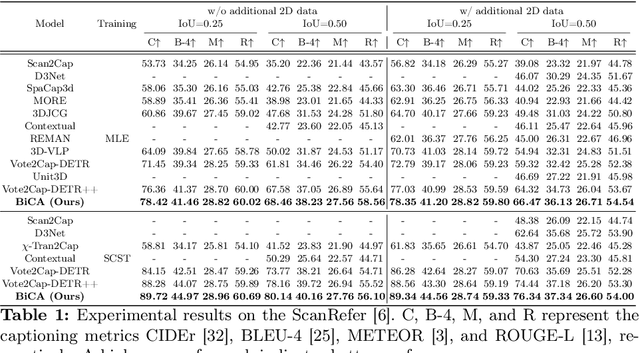
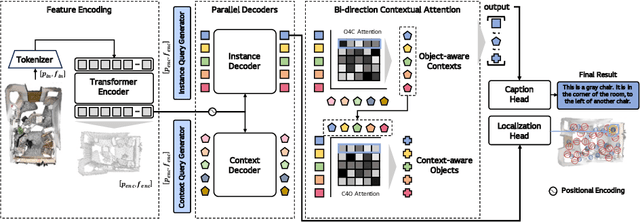
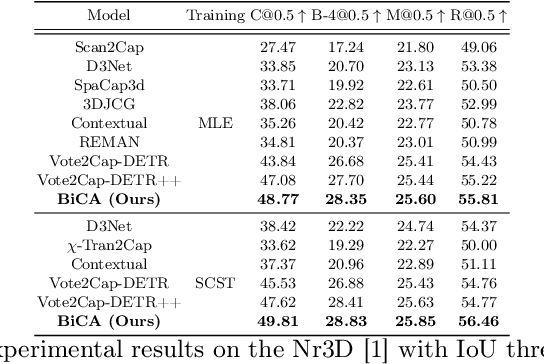
Abstract:3D dense captioning is a task involving the localization of objects and the generation of descriptions for each object in a 3D scene. Recent approaches have attempted to incorporate contextual information by modeling relationships with object pairs or aggregating the nearest neighbor features of an object. However, the contextual information constructed in these scenarios is limited in two aspects: first, objects have multiple positional relationships that exist across the entire global scene, not only near the object itself. Second, it faces with contradicting objectives--where localization and attribute descriptions are generated better with tight localization, while descriptions involving global positional relations are generated better with contextualized features of the global scene. To overcome this challenge, we introduce BiCA, a transformer encoder-decoder pipeline that engages in 3D dense captioning for each object with Bi-directional Contextual Attention. Leveraging parallelly decoded instance queries for objects and context queries for non-object contexts, BiCA generates object-aware contexts, where the contexts relevant to each object is summarized, and context-aware objects, where the objects relevant to the summarized object-aware contexts are aggregated. This extension relieves previous methods from the contradicting objectives, enhancing both localization performance and enabling the aggregation of contextual features throughout the global scene; thus improving caption generation performance simultaneously. Extensive experiments on two of the most widely-used 3D dense captioning datasets demonstrate that our proposed method achieves a significant improvement over prior methods.
Spherical World-Locking for Audio-Visual Localization in Egocentric Videos
Aug 09, 2024
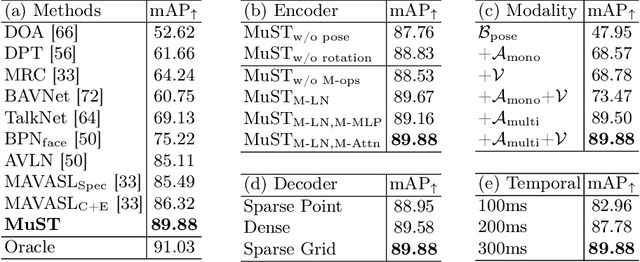


Abstract:Egocentric videos provide comprehensive contexts for user and scene understanding, spanning multisensory perception to behavioral interaction. We propose Spherical World-Locking (SWL) as a general framework for egocentric scene representation, which implicitly transforms multisensory streams with respect to measurements of head orientation. Compared to conventional head-locked egocentric representations with a 2D planar field-of-view, SWL effectively offsets challenges posed by self-motion, allowing for improved spatial synchronization between input modalities. Using a set of multisensory embeddings on a worldlocked sphere, we design a unified encoder-decoder transformer architecture that preserves the spherical structure of the scene representation, without requiring expensive projections between image and world coordinate systems. We evaluate the effectiveness of the proposed framework on multiple benchmark tasks for egocentric video understanding, including audio-visual active speaker localization, auditory spherical source localization, and behavior anticipation in everyday activities.
 Add to Chrome
Add to Chrome Add to Firefox
Add to Firefox Add to Edge
Add to Edge